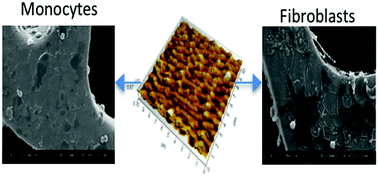In vitro study on the response of RAW264.7 and MS-5 fibroblast cells on laser-induced periodic surface structures for stainless steel alloys†
Abstract
The manner in which cells interact with a surface is mainly determined by the surface chemistry, surface charge, curvature and micro-topography of the surface. This study investigates the bio response of two metallic alloy coronary stents with Laser Induced Periodic Surface Structures (LIPSS) produced by femtosecond laser pulses at 515 nm and 1030 nm wavelengths. The study relates the bio response to changes in micro-topography and chemical composition. LIPSS were generated in this study by applying femtosecond pulses with a 500 fs pulse duration at a high repetition rate to smooth polished Platinum Stainless Steel (Pt:SS) and 316LSS stent surfaces, with an original roughness value of 2.9 ± 0.2 nm and 1.5 ± 0.2 nm respectively. LIPSS structures were formed by exposure to laser radiation slightly above the applied threshold fluence using a Gaussian laser beam in air. Experiments were performed at two different wavelengths, 1030 nm and 515 nm, to generate different periodic topographies. When the laser wavelength is increased the LIPSS period and depth also increases, thereby increasing the roughness. LIPSS features were characterized using techniques such as Atomic Force Microscopy (AFM) and X-ray Photoelectron Spectroscopy (XPS). This study identifies how LIPSS impact the attachment of monocyte cells (RAW 264.7) and fibroblast cells (MS-5) in vitro. The cellular reactions of un-textured to LIPSS surfaces were compared. It was found using Scanning Electron Microscopy (SEM) that different cells either attached or detached to LIPSS roughness (ranging from 29 nm to 50 nm). Fibroblast cells did not adhere to un-textured surfaces but formed a monolayer on LIPSS surfaces. This indicates that the LIPSS surface is non-toxic. Monocytes show a high affinity to bare un-textured surfaces and failed to firmly attach onto textured surfaces. In the case of stents, it is an advantage that the concentration of monocytes decreases when LIPSS are introduced as this can reduce thrombosis occurring. In the future, laser structured surfaces with various topographies can offer new bio-functionalities in the area of medical implants.


 Please wait while we load your content...
Please wait while we load your content...